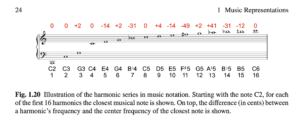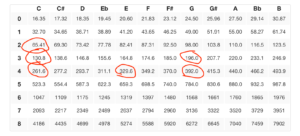This post was published in 2021-12-31. Obviously, expired content is less useful to users if it has already pasted its expiration date.
Table of Contents
乐理的中英文对照 *
上一次的内容见:🔗 [2021-12-15 - Truxton's blog] https://truxton2blog.com/2021-12-15/#乐理的中英文对照_Music_Representations_cheat_sheet
Harmony和Chord
harmony 和声;chord 和弦
In music, harmony refers to the simultaneous sound of different notes that form a cohesive entity in the mind of the listener. The main constituent components of harmony, at least in the Western music tradition, are chords, which are musical constructs that typically consist of three or more notes.
Harmonics, harmonics series,泛音
有好几个用法,但一般来说harmonics用的多:
overtone(s) 泛音(aliquot tone, harmonics, flageolet tone 即upper partials)
此外,在信号系统相关的书籍中,harmonic series的成员也被称为“x个成谐波关系的复指数”.
(来自🔗 [音乐术语英文名称汇总(一) - 知乎] https://zhuanlan.zhihu.com/p/35999407)
有关泛音列的应用,见之前学过的harmonic model:🔗 [ASPMA课程大纲复习(2021-06初版) - Truxton's blog] https://truxton2blog.com/aspma-syllabus-review/
摘录一些有关泛音列的重要解释:
通常,乐器上发出的每个音都是基音和上方泛音的复合音,唯一的例外是音叉。
几乎所有乐器除了可发出基频音以外亦会伴随著较高频的声音,称为泛音。在有明显音高的乐器中,弦或空气管之间会有因反射而造成波长相同、行进方向相反的波,而因为这些彼此互相干涉而产生波长、频率不同的谐波,在音乐上的名词即为泛音。而泛音列的波长分别为弦长或是空气管长的1/2、1/3、1/4、1/5、1/6……等倍。
https://zh.wikipedia.org/zh-hans/%E6%B3%9B%E9%9F%B3%E5%88%97
另外还有一个概念:harmonic series partial
A "complex tone" (the sound of a note with a timbre particular to the instrument playing the note) "can be described as a combination of many simple periodic waves (i.e., sine waves) or partials, each with its own frequency of vibration, amplitude, and phase".[1] (See also, Fourier analysis.)
A partial is any of the sine waves (or "simple tones", as Ellis calls them[2] when translating Helmholtz) of which a complex tone is composed, not necessarily with an integer multiple of the lowest harmonic.
https://en.wikipedia.org/wiki/Harmonic_series_(music)
注意到harmonic series partial都是f0的整数倍(忘记了?再复习这里和这里),但千万不要错误记忆成下面的模式:
这是错误的!!!
f0=C2,所以harmonics series为f0, 2f0, 4f0, 8f0...:C2, C3, C4, C5, C6, C7...
这就是完全没有记住频率对照表的结果!一个 octave 才是[mathjax]\omega, 2\omega, 4\omega, 8\omega \cdots[/mathjax],而一个harmoic series应该是[mathjax]\omega, 2\omega, 3\omega, 4\omega, 5\omega, 6\omega \cdots[/mathjax]
正确的序列应该是这样:


但是...等等!为什么书上的[mathjax]\mathrm{B}^{\flat}4[/mathjax](理论值466.2)和我们计算的65.41*7=457.87差别有点大?
注意到上面这张图顶部的红字和图中的注释:
Starting with the note C2, for each of the first 16 harmonics the closest musical note is shown.
所以说harmonic series计算出的music note并不是100%严格一致的,计算得到的frequency和music note frequency可能会存在差异,这个差异值可以使用 cents 表示(《fundamentals of ...》 P22):
[mathjax-d]\log _{2}\left(\frac{\omega_{1}}{\omega_{2}}\right) \cdot 1200[/mathjax-d]
这种差异也被称为inharmonicity:
The term inharmonicity is used to denote a measure of the deviation of a partial from the closest ideal harmonic, typically measured in cents for each partial.
P23
同时,上面提到的 cents 也有它的更完善定义:(来自wikipedia: 🔗 Cent (music) - Wikipedia)
The cent is a logarithmic unit of measure used for musical intervals. Twelve-tone equal temperament divides the octave into 12 semitones of 100 cents each. Typically, cents are used to express small intervals, or to compare the sizes of comparable intervals in different tuning systems, and in fact the interval of one cent is too small to be perceived between successive notes.
https://en.wikipedia.org/wiki/Cent_(music)